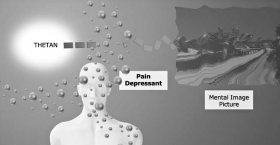Doctors and others prescribe painkillers such as aspirin, tranquilizers,
However, it has never been known in chemistry or medicine exactly how or why these things worked. Such compositions are derived by accidental discoveries that “such and so depresses pain.”
The effects of existing compounds are not uniform in result and often have very bad side effects.
As the reason they worked was unknown, very little advance has been made in biochemistry—the chemistry of life processes and substances. If the reason they worked were known and accepted, possibly chemists could develop some actual painkillers which had minimal side effects.
Pain or discomfort of a psychosomatic nature comes from
By actual clinical test, the actions of aspirin and other pain depressants are to:
A. Inhibit the ability of the thetan to create mental image pictures
and also
B. To impede the electrical conductivity of nerve channels.
As a result, the thetan is rendered stupid, blank, forgetful,
When the drugs wear off or start to wear off, the ability to create mental image pictures starts to return and turns on somatics (body sensations, illnesses or pains or discomforts) much harder. One of the answers a person has for this is more drugs. To say nothing of heroin, there are aspirin addicts. The compulsion stems from a desire to get rid of the somatics and unwanted sensations again. The being gets more and more wooden, requiring more and more quantity and more frequent use.
Sexually it is common for someone on drugs to be very stimulated at first. But after the original sexual “kicks,” the stimulation of sexual sensation becomes harder and harder to achieve. The effort to achieve it becomes obsessive while it itself is less and less satisfying.
The cycle of drug
If one were working on the problem of pain relief biochemically, the least harmful pain depressant would be one that inhibited the creation of mental image pictures with minimal resulting “woodenness” or stupidity and which was body-soluble (easily dissolved in the body) so that it passed rapidly out of the nerves and system.
There are unwanted sensations that drugs block off, but there is a whole sector of desirable sensations, and drugs block off all sensations.
The only defense that can be made for drugs is that they give a short, quick
Dexterity, ability and alertness are the main things that prevent getting into painful situations. These all vanish with drugs. So drugs set you up to get into situations which are truly disastrous and keep you that way.
One has a choice between being dead with drugs or being alive without them. Drugs rob life of the sensations and joys which are the only reasons for living anyhow.
drugs or other agents that cause sleep or drowsiness.
three-dimensional color pictures with sound and smell and all other perceptions, plus the conclusions or speculations of the individual. They are mental copies of one’s perceptions sometime in the past, although in cases of unconsciousness or lessened consciousness they exist below the individual’s awareness.
the person himself—not his body or his name, the physical universe, his mind or anything else—it is that which is aware of being aware; the identity which is the individual. The term thetan was coined to eliminate any possible confusion with older, invalid concepts. It comes from the Greek letter theta which the Greeks used to represent thought or perhaps spirit, to which an n is added to make a noun in the modern style used to create words in engineering.
characterized by delusion, a fixed false belief; something that is perceived in a way different from the way it is in reality. From the word delude, which means to mislead the mind or judgment of, and illusion, which means something that deceives by producing a false or misleading impression of reality.
the reactivation of a memory of a past unpleasant experience due to similar circumstances in the present approximating circumstances of the past.
a state of unawareness of what is going on.


